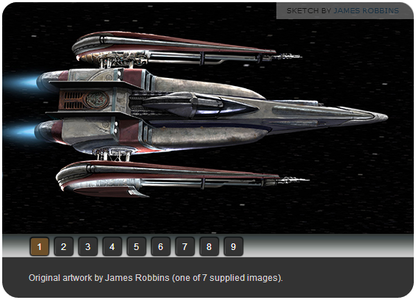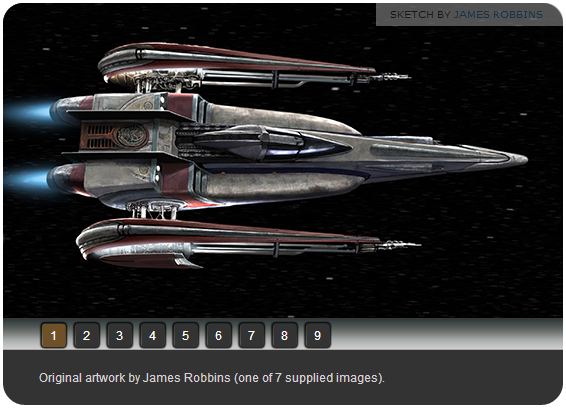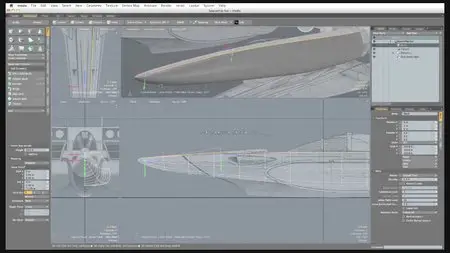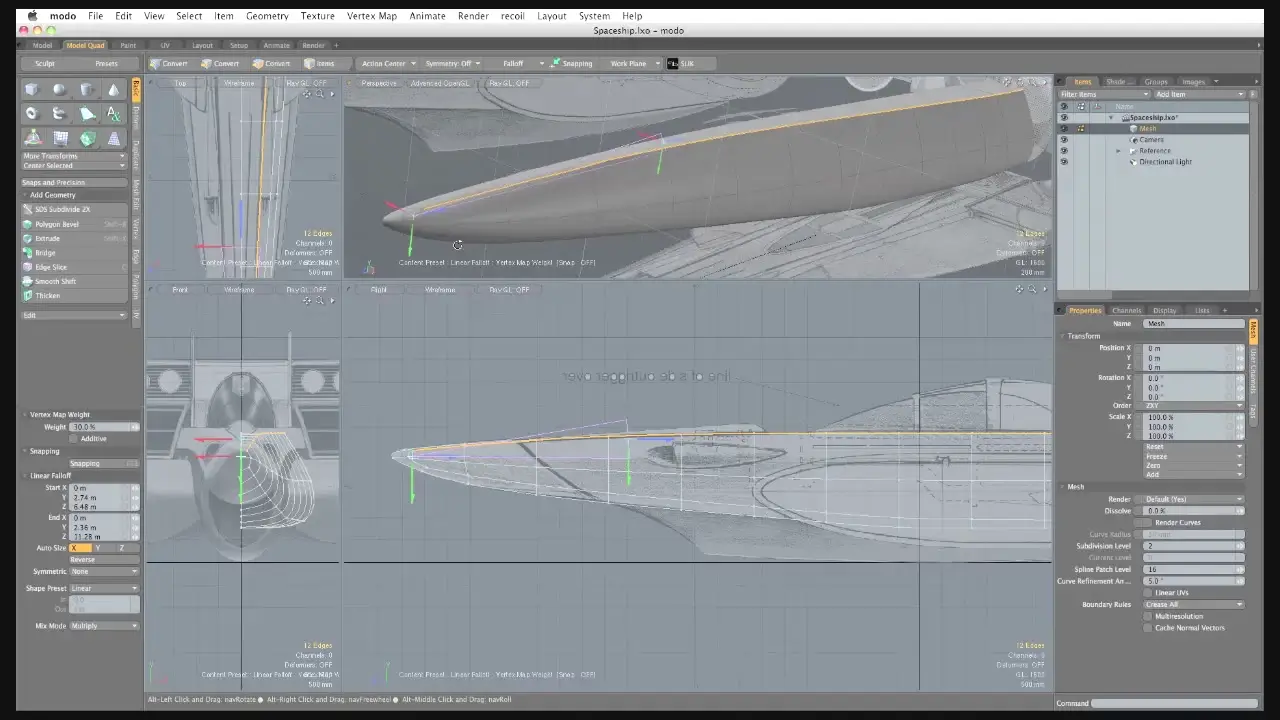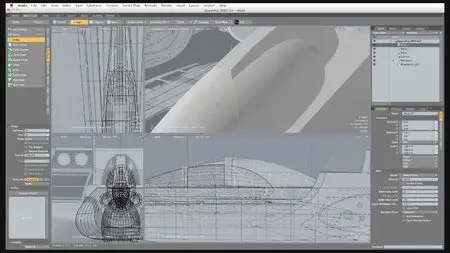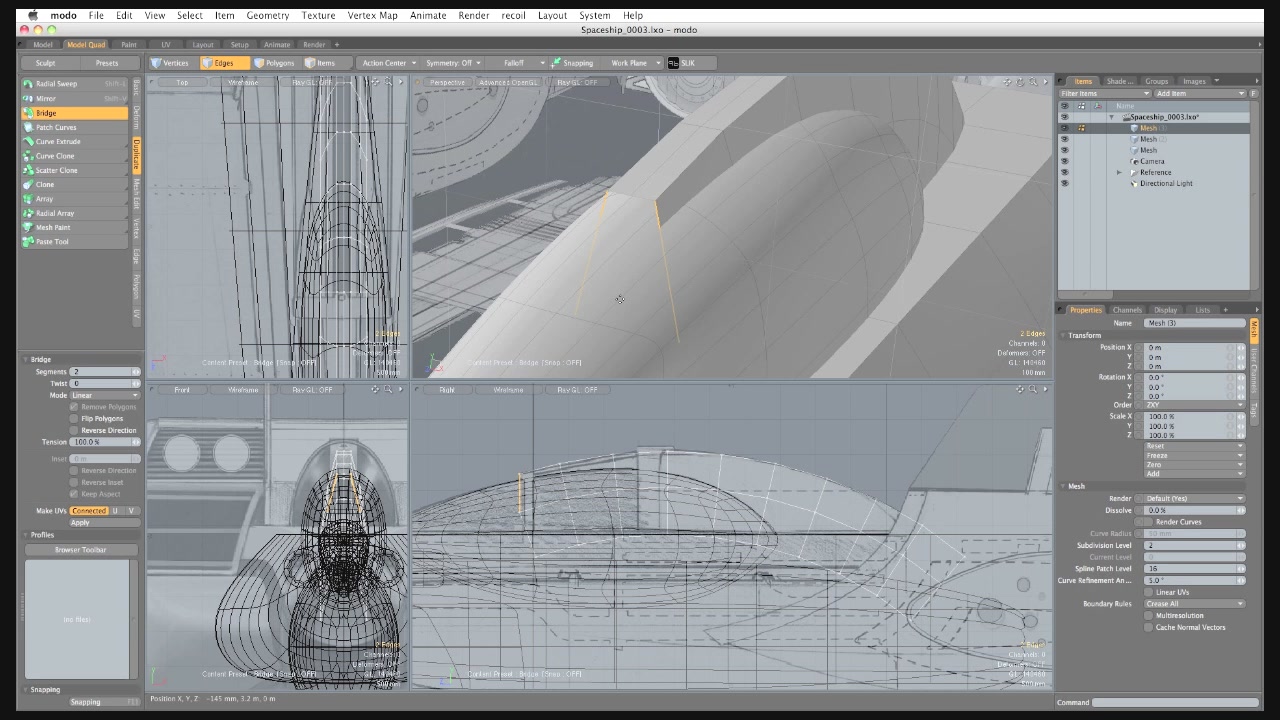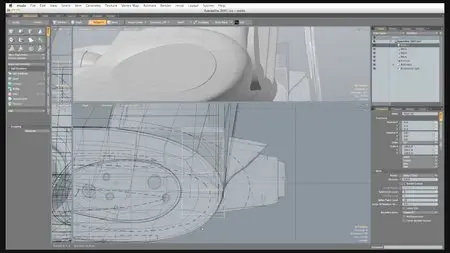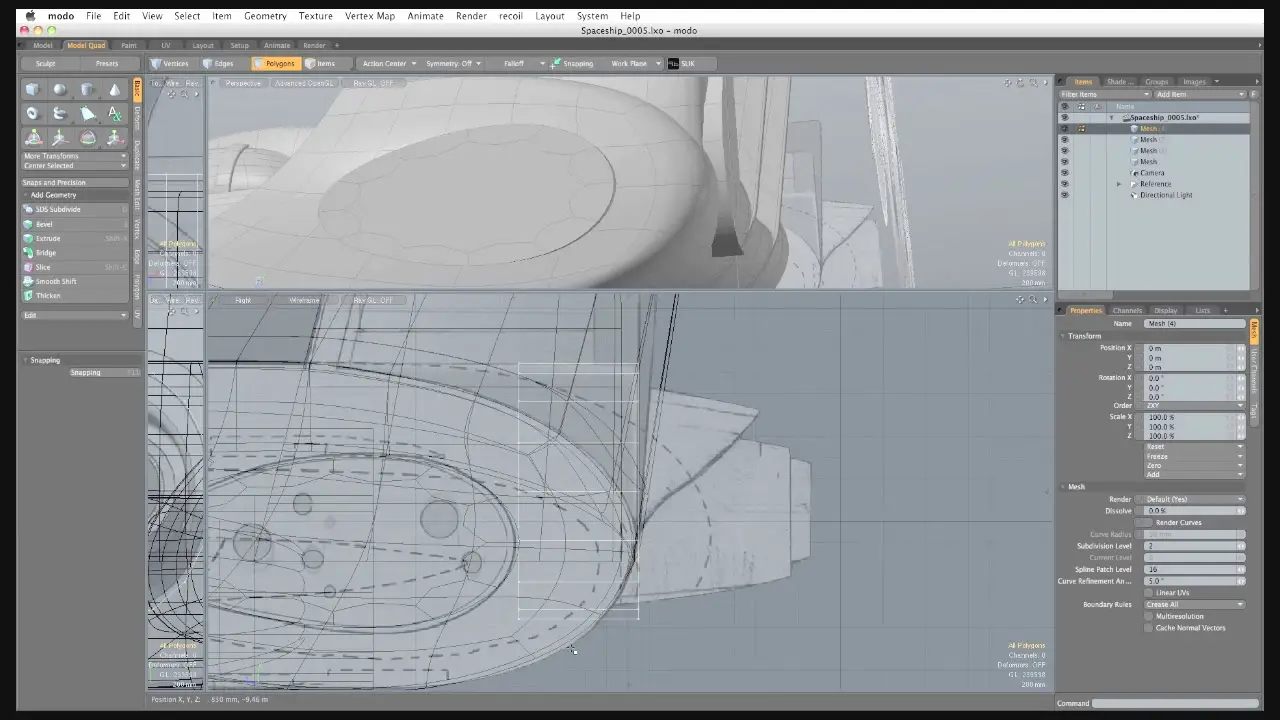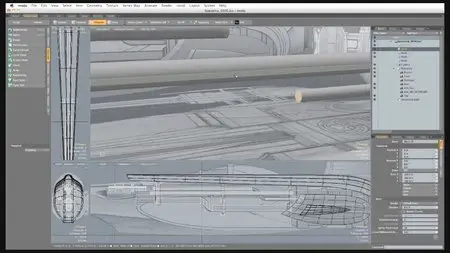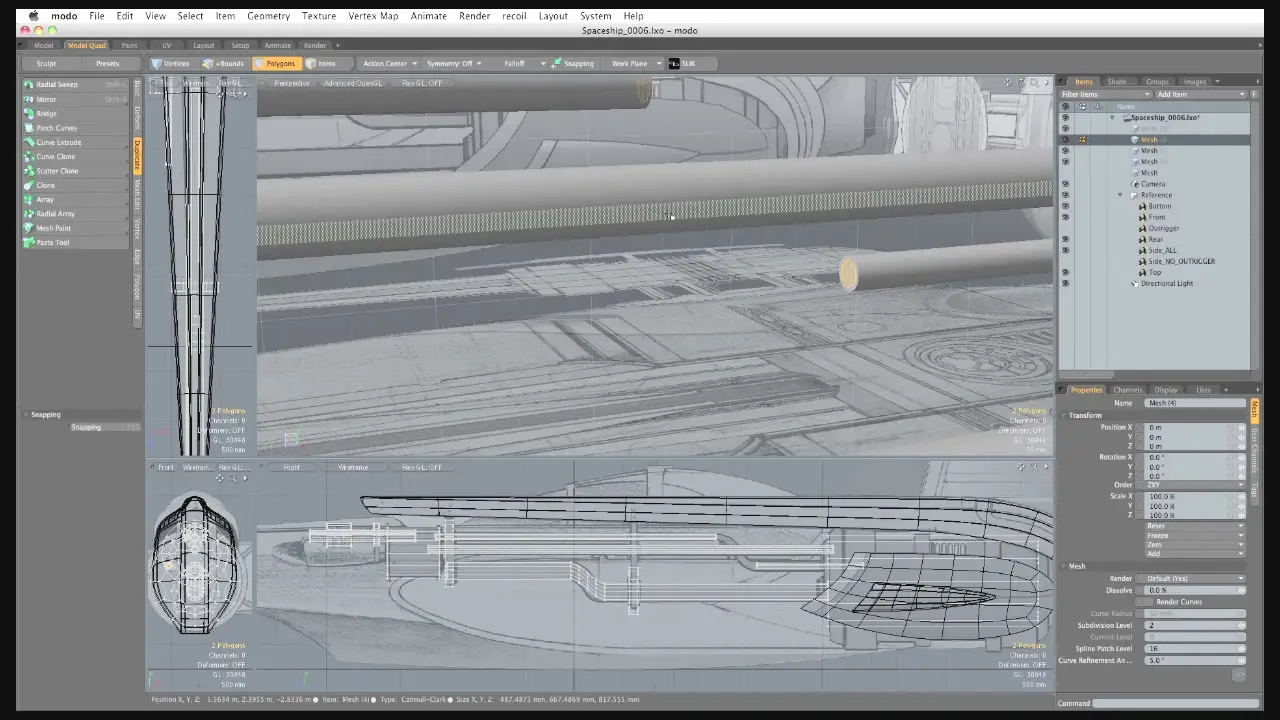Luxology: Spaceship Modeling in modo 501
English | MOV + project files | 1280 x 720 | AVC ~484 Kbps | 10 fps
AAC | 98.3 kbps | 22.05 KHz | 2 channels | 05:01:40 | 1.4 GB
AAC | 98.3 kbps | 22.05 KHz | 2 channels | 05:01:40 | 1.4 GB
Genre: Video Tutorial / 3D-graphics
The modeling techniques used in this tutorial are not exclusive to spaceships; they can be used to create any vehicle, from a car to a plane or even a boat. What’s important is the methodology, and how to organize and be in control of modeling a large project from reference drawings. The aim of this tutorial is to teach you a specific methodology with your future hard surface modeling projects in modo.This video tutorial was developed for modo 501. Users of later versions of modo will find the tutorial useful, but will have to adapt some instructions to new techniques found in more recent versions of modo.
Contents:
5 video segments by Andy Brown demonstrating step-by-step how to model a Spaceship based on the supplied reference drawings. 8 pieces of reference artwork by James Robbins. 5 modo starting scenes (one for each video) so the tutorial sections can be completed in any order. 3 finished modo scenes, including two animations. 7 mesh presets.
Video Segment 1 Blocking Out
In this video we concentrate on developing a proxy model for the project. This model will then go on to form the backbone of the project and be a constant source of reference. During this process we look at setting up Backdrop Items, and most importantly, how to interpret a two dimensional drawing to create a model that it is both accurate and flexible so it can be an integral part of an iterative design process.
Video Segment 2 Hull Topology
With the proxy model as a template we can now start building the final model. We start with the main hull of the spacecraft. This is the largest part of the model, and the structure from which all the other details are connected. Through the video we investigate a method for developing topology that will accommodate that detail, while at the same time preserving the clean flowing lines of the hull. The hull is created using Pixar Subdivision Surfaces and we make extensive use of edge weighting.
Video Segment 3 Hull Detailing
With the main structure in place we are now free to embellish it with details, and in this video we look at three different ways of approaching it. Firstly we look at model bashing, or how to manipulate presets to quickly populate less important areas of the model. Secondly we look at modeling details that are more intrinsic to the design but not directly connected to the hull. And thirdly we look at how to cut into areas of the hull to add details that are directly connected to it. During this video we also look at some simple rigging techniques that allow us to evaluate the integrity of the details we’re creating.
Video Segment 4 Cockpit
The cockpit of a plane, the bridge of a spaceship, or any kind of control room, are always fascinating areas to model because they bristle with controls and are visually rich. They are also the areas in which a human will interact with a vehicle making it a natural area of focus. In this video we assume the camera is going to get really close and have some fun building a canopy that will open and close believably, and develop some detailed control surfaces using the Model Bashing Kit.
Video Segment 5 Outrigger
We complete the tutorial by modeling the outriggers, which are very important parts of the design and are little microcosms of the whole project. We develop smooth weighted topology in the same way as we did in Video 2, and add details and embellish the design like we did in Video 3, but the most interesting thing about this section is when we re-design an area and add structures that are not present in the reference in order for it to function in a certain way.
Software Compatibility:
modo 501 (Although not essential, the Model Bashing Kit is required for the completion of the last section of Video 4.)
Project files are included
More Info: http://www.luxology.com/store/spaceship/index.aspx
General
Complete name : 1_Blocking_Out.mov
Format : MPEG-4
Format profile : QuickTime
Codec ID : qt
File size : 249 MiB
Duration : 59mn 34s
Overall bit rate : 585 Kbps
Encoded date : UTC 2011-06-24 09:55:54
Tagged date : UTC 2011-06-24 11:39:11
Writing library : Apple QuickTime
Video #1
ID : 1
Format : AVC
Format/Info : Advanced Video Codec
Format profile : Main@L3.1
Format settings, CABAC : No
Format settings, ReFrames : 2 frames
Codec ID : avc1
Codec ID/Info : Advanced Video Coding
Duration : 59mn 34s
Source duration : 59mn 34s
Bit rate : 484 Kbps
Width : 1 248 pixels
Original width : 1 280 pixels
Height : 702 pixels
Original height : 720 pixels
Display aspect ratio : 16:9
Frame rate mode : Constant
Frame rate : 10.000 fps
Color space : YUV
Chroma subsampling : 4:2:0
Bit depth : 8 bits
Scan type : Progressive
Bits/(Pixel*Frame) : 0.055
Stream size : 206 MiB (83%)
Source stream size : 206 MiB (83%)
Language : English
Encoded date : UTC 2011-06-24 11:14:15
Tagged date : UTC 2011-06-24 11:39:11
Color primaries : BT.709-5, BT.1361, IEC 61966-2-4, SMPTE RP177
Transfer characteristics : BT.709-5, BT.1361
Matrix coefficients : BT.709-5, BT.1361, IEC 61966-2-4 709, SMPTE RP177
Audio #2
ID : 2
Format : AAC
Format/Info : Advanced Audio Codec
Format profile : LC
Codec ID : 40
Duration : 59mn 33s
Bit rate mode : Constant
Bit rate : 98.3 Kbps
Nominal bit rate : 128 Kbps
Channel(s) : 2 channels
Channel positions : Front: L R
Sampling rate : 22.05 KHz
Compression mode : Lossy
Stream size : 41.9 MiB (17%)
Language : English
Encoded date : UTC 2011-06-24 11:14:15
Tagged date : UTC 2011-06-24 11:39:11
Complete name : 1_Blocking_Out.mov
Format : MPEG-4
Format profile : QuickTime
Codec ID : qt
File size : 249 MiB
Duration : 59mn 34s
Overall bit rate : 585 Kbps
Encoded date : UTC 2011-06-24 09:55:54
Tagged date : UTC 2011-06-24 11:39:11
Writing library : Apple QuickTime
Video #1
ID : 1
Format : AVC
Format/Info : Advanced Video Codec
Format profile : Main@L3.1
Format settings, CABAC : No
Format settings, ReFrames : 2 frames
Codec ID : avc1
Codec ID/Info : Advanced Video Coding
Duration : 59mn 34s
Source duration : 59mn 34s
Bit rate : 484 Kbps
Width : 1 248 pixels
Original width : 1 280 pixels
Height : 702 pixels
Original height : 720 pixels
Display aspect ratio : 16:9
Frame rate mode : Constant
Frame rate : 10.000 fps
Color space : YUV
Chroma subsampling : 4:2:0
Bit depth : 8 bits
Scan type : Progressive
Bits/(Pixel*Frame) : 0.055
Stream size : 206 MiB (83%)
Source stream size : 206 MiB (83%)
Language : English
Encoded date : UTC 2011-06-24 11:14:15
Tagged date : UTC 2011-06-24 11:39:11
Color primaries : BT.709-5, BT.1361, IEC 61966-2-4, SMPTE RP177
Transfer characteristics : BT.709-5, BT.1361
Matrix coefficients : BT.709-5, BT.1361, IEC 61966-2-4 709, SMPTE RP177
Audio #2
ID : 2
Format : AAC
Format/Info : Advanced Audio Codec
Format profile : LC
Codec ID : 40
Duration : 59mn 33s
Bit rate mode : Constant
Bit rate : 98.3 Kbps
Nominal bit rate : 128 Kbps
Channel(s) : 2 channels
Channel positions : Front: L R
Sampling rate : 22.05 KHz
Compression mode : Lossy
Stream size : 41.9 MiB (17%)
Language : English
Encoded date : UTC 2011-06-24 11:14:15
Tagged date : UTC 2011-06-24 11:39:11
For more, Visit my AH-blog
no mirrors please, Follow The Rules


